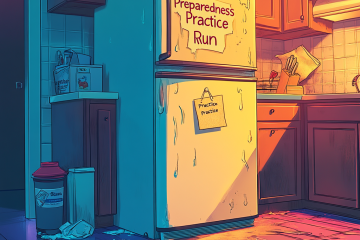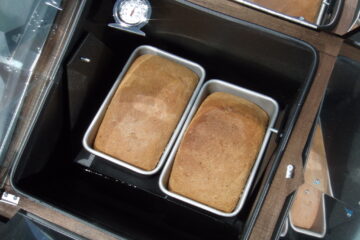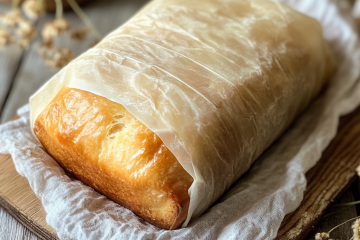When most people think about eating from their food storage, they think about mundane wheat, rice, and beans. If I had to live on that, I may very well starve to death out of boredom, also known as “appetite fatigue.” There are two key ways to avoid this from happening to you and your family if you’re forced to live off of food storage. 1) Store what you eat. 2) Learn to use what you store. 3) Rotate. 4) Eat what you store.
While this may sound simple, I find that frequently, when I evaluate a client’s food storage, they are storing items that they have no idea how to convert into edible food, and in some cases, they are even storing items that they are allergic to!
Here are the facts. If you attempt to go from what you’re eating every day now to surviving off of whole wheat, you could actually die in extreme circumstances because of the digestive disorders it could cause as it shocks your digestive system. If you intend to use wheat in an emergency, you better begin acclimating your body to wheat right now. (It’s the only reason why I learned to make bread, Fortunately people love my bread!) So introducing wheat into your diet on a daily basis now is one way to avoid shocking your system literally to death. And it’s part of the fundamental of “learning to use what you store.”
Now some may ask, “Don’t we already eat wheat all the time?” You eat some form of wheat, no doubt, yes, unless you’re gluten free. However, going from white flour products to 100% whole wheat will be a shock to the system. It’s a very different experience on the digestive system, and a rough one at that.
I’ve had one woman show me her ample supplies to make some wonderful sounding dishes, but she’s never attempted to make them for herself or her family. That’s a catastrophe waiting to happen. Remember, the time for preparation is over when the opportunity (or disaster) appears. Another way to prevent a system shock when you’re forced to convert your lifestyle as the result of an emergency is to store items such as Kamut, Amarath, Quinoa, Millet, and Spelt. These types of grains mixed in generously with wheat will prevent the negative effects of shocking your body with straight wheat. Oh, and by the way, be sure you learn how to eat these items as well. (Yes, you can sprout them also). Given the choices though, I prefer to introduce wheat into my body regularly. The reason being is that the other grain choices above are 4 to 10 times more expensive than wheat. And that’s saying a lot considering how much wheat has gone up in pricing over the last 2 years. Learning to use what you store also requires a level of awareness.
As you use recipes in your regular meal making activities, ask yourself if you have the items necessary to create such a meal with what you’ve got in storage (This includes what you may need to actually cook the meal with such as a Dutch Oven, Solar Oven, alternatively fueled stoves, etc. I frequently use my Joy Cook stoves for testing emergency preparedness recipes. They are made in Korea and I always see them being sold at sporting goods stores as well as trade shows for camping, boating and guns). I also specifically look for recipes in which I can adapt the items easily, or already stock in my food storage. For example, today I played around with using peanut butter, ginger vinaigrette and fettuccine. It turned out nicely. But then again I like Thai flavored types of food as well. Here is the recipe for you to test out on your finicky eaters.
Ginger Peanut Fettuccine
1 box of (8 oz.) of fettuccine ½ cup of peanut butter (crunchy is ideal for this recipe) ¾ cup of ginger vinaigrette dressing 1 tablespoon of minced garlic. (I buy mine by the large jar and use it all year round) Reserve 1 ¼ cup of the pasta water Cook fettuccine according to box directions. Drain completely, setting aside the reserved pasta water. Set aside your pasta while you make the sauce. Returning your pan to the hot surface, simply add your garlic, dressing, peanut butter and pasta water, stirring until smooth. Add cooked pasta. Stir well until mixed. Makes four servings which include necessary fats, proteins, and carbohydrates. I like to sprinkle a bit of dried parsley over each serving as well. Enjoy!
I’ll address more of the fundamental of “storing what you eat” in future blogs.



10 Comments
Kandace · March 4, 2009 at 12:00 pm
Thanks for your post and the link to your website. Like you, I’m always looking for ways to incorporate what I have stored into what I actually eat. I’ve on a two month pantry challenge (not going to the store), eating what I have on hand. So far, I’m still alive to write about it.
Kandace · March 4, 2009 at 12:00 pm
Thanks for your post and the link to your website. Like you, I’m always looking for ways to incorporate what I have stored into what I actually eat. I’ve on a two month pantry challenge (not going to the store), eating what I have on hand. So far, I’m still alive to write about it.
Kellene · March 7, 2009 at 11:13 am
Glad to hear that Kandace! Be sure to replenish when you’re finished with your challenge. Keep checking back here for recipe ideas as well! And if you have learned to make a great bread, our readers would love your tips also.
Kellene · March 7, 2009 at 11:13 am
Glad to hear that Kandace! Be sure to replenish when you’re finished with your challenge. Keep checking back here for recipe ideas as well! And if you have learned to make a great bread, our readers would love your tips also.
Dance · June 30, 2011 at 8:24 pm
Kellene,
I ran across a bread recipe that even beginners can do.
Dissolve 2 tablespoons of yeast and 4 tablespoons of sugar in 2 cups of hot water. Let it sit 10 minutes then stir in flour a half cup at a time until it forms into a ball. This should take about three cups. Turn out on a floured surface and knead it about 5 minutes, add flour as necessary to keep it from being sticky this should take between 1.5 and 2 cups. Grease two loaf pans, split the dough and form into a loaf before putting them into the pans. Allow to rise in a warm place with a damp towel over them for about thirty to fourty minutes. Bake in a 400 degree oven for about the same amount of time. The loaves should sound hollow when done. The best flour I can recommend is a mixture of bread flour and wheat flour and the sugar can be substituted with honey.
Dance · June 30, 2011 at 8:24 pm
Kellene,
I ran across a bread recipe that even beginners can do.
Dissolve 2 tablespoons of yeast and 4 tablespoons of sugar in 2 cups of hot water. Let it sit 10 minutes then stir in flour a half cup at a time until it forms into a ball. This should take about three cups. Turn out on a floured surface and knead it about 5 minutes, add flour as necessary to keep it from being sticky this should take between 1.5 and 2 cups. Grease two loaf pans, split the dough and form into a loaf before putting them into the pans. Allow to rise in a warm place with a damp towel over them for about thirty to fourty minutes. Bake in a 400 degree oven for about the same amount of time. The loaves should sound hollow when done. The best flour I can recommend is a mixture of bread flour and wheat flour and the sugar can be substituted with honey.
Stephanie · March 15, 2012 at 8:33 pm
Just wondering about quinoa. How long will it store in an airtight container or vac pac? Also what about usage of wheat. Ok I don’t eat bread or much of any carbs including pasta but I do use flour to batter, make pancakes, the occassional biscuits. My husband goes thru about a loaf of bread a week but sometimes I do have excess left over. What amount per person would you suggest just for that type of usage? Thanks, this blog is a lifesaver!
Kellene Bishop · March 15, 2012 at 8:35 pm
350 pounds of grains, per person, per year. This includes any pasta or crackers you may have stocked up as well.
Quinoa can benefit from the use of food-grade DE as well. In an airtight container you should have no problem with 5-8 years, especially if it’s glass.
Stephanie · March 15, 2012 at 8:33 pm
Just wondering about quinoa. How long will it store in an airtight container or vac pac? Also what about usage of wheat. Ok I don’t eat bread or much of any carbs including pasta but I do use flour to batter, make pancakes, the occassional biscuits. My husband goes thru about a loaf of bread a week but sometimes I do have excess left over. What amount per person would you suggest just for that type of usage? Thanks, this blog is a lifesaver!
Kellene Bishop · March 15, 2012 at 8:35 pm
350 pounds of grains, per person, per year. This includes any pasta or crackers you may have stocked up as well.
Quinoa can benefit from the use of food-grade DE as well. In an airtight container you should have no problem with 5-8 years, especially if it’s glass.
Comments are closed.